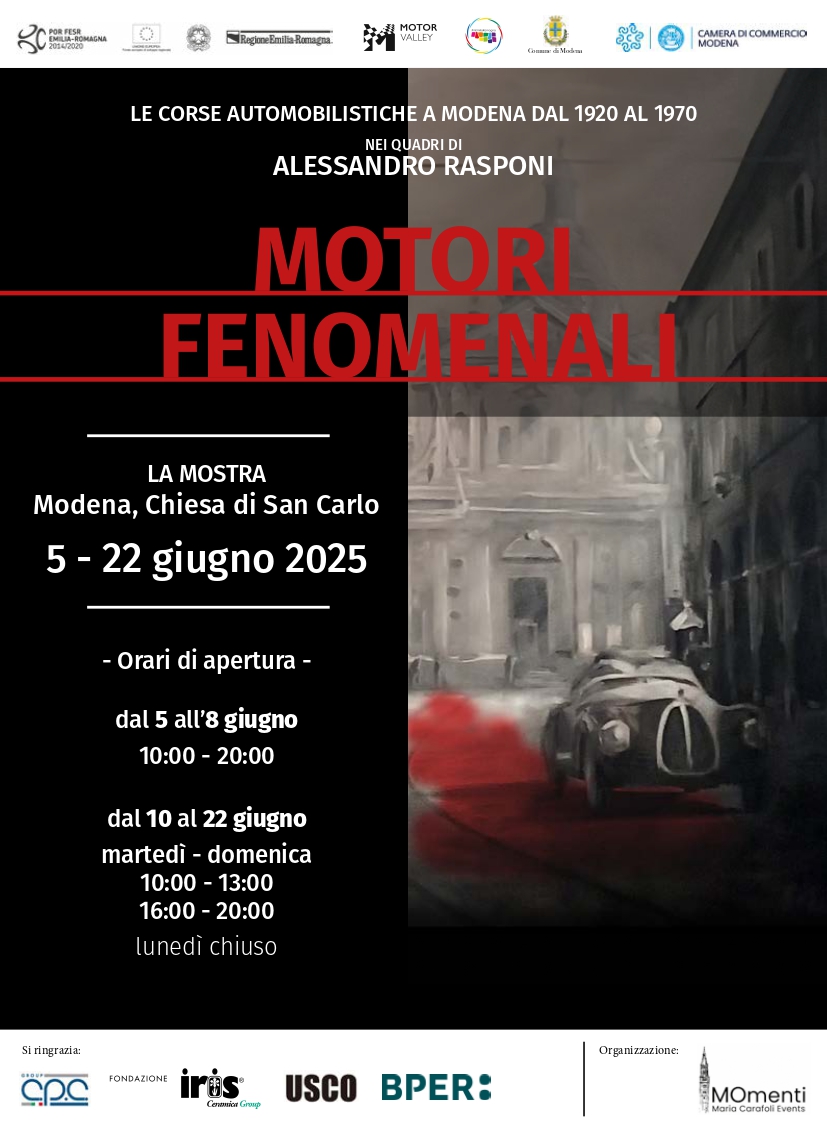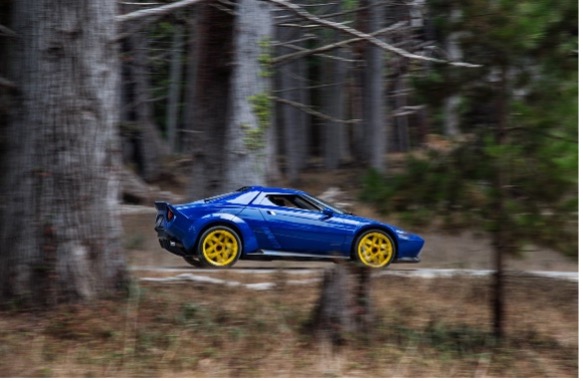
Everyone knows it, but one still wonders why Emilia-Romagna is the land of motors.
And above all, why this (agricultural) region—and particularly one of its cities, Modena—continues to make headlines for its phenomenal engines. That’s precisely the title of the exhibition organized as part of the Motor Valley 2025 initiatives by Momenti di Maria Carafoli.
Exhibition Theme
Within the context of Modena’s historic and exceptional relationship with the world of motorsports and racing, the exhibition aims to illustrate to the public—through the paintings of artist Alessandro Rasponi—the car races that took place in Modena from 1920 to 1970.
Each painting features two protagonists: the city of Modena and the cars.
The depictions of Modena—its landmarks, streets, and its famous racetrack (active until the 1970s)—serve both as the setting and as an active character, highlighting its role in hosting globally renowned personalities and manufacturers.
In Rasponi’s work, spectators can see exactly what fans of those historic races would have seen: “phenomenal engines” (Maserati, Ferrari, Stanguellini, Alfa Romeo, etc.) zooming past the city’s monuments or along the new racetrack inaugurated in the 1950s, the most iconic of post-war Italy.
Historic Context
After the end of dangerous street circuit racing—where even Enzo Ferrari had once competed—due to fatal accidents involving both drivers and spectators, Modena inaugurated a new aero-racetrack on May 9, 1950 (it also served as an airport, hence the name aerautodromo).
The circuit, nicknamed “Little Indianapolis,” hosted legendary drivers like Villoresi, Fangio, and Ascari. Even Clay Regazzoni managed to race there in 1971 before the track was closed.
Rasponi’s paintings also depict these legendary figures racing not for a driving Enzo Ferrari, but for Ferrari the constructor—caught in a fierce rivalry between his Ferraris and the Maseratis. A rivalry that helped define the identity of the city itself.
Modena is shown as a city filled with spectators—on the grandstands of the new circuit or watching from balconies along the Via Emilia (the new track ran parallel to it). Rasponi captures these scenes, including the futuristic architecture of the 1960s pit buildings and Enzo Ferrari coaching his drivers before the start.
A Journey Through Speed and Identity
To relive the atmosphere of high-stakes competition and understand why Modena, and not some other city, became globally famous for motors, Rasponi’s canvases depict:
The faces of legendary drivers
The focused expressions of constructors
The fascinated gazes of an early racing public
at a time when cars weren’t just means of transport, but phenomenal engines, captivating for their unmatched speed—unlike anything the world had seen.
Two particularly interesting sections of the exhibition focus on:
The “flying mile” races of 1909 and 1910
The countryside test drives conducted by Italian automotive pioneers like Stanguellini, Ferrari, and Orsi before the racetrack was built
Here, a still-rural Italy (where horse-drawn carts ruled dusty roads) collided—often literally—with the fast-moving future.
Structure of the Exhibition
The exhibition is divided into two main sections:
Alessandro Rasponi’s Paintings – the heart of the exhibition
Ceramic Model Cars – enamelled racing car models crafted by students of class 4B (Ceramics Section) from the Adolfo Venturi State Art High School in Modena, under the guidance of Professor Villani and school director Maria Luigia Paolino.
The ceramic tradition—just like motors—is a significant economic and cultural asset in the province of Modena. This part of the exhibit underscores the economic importance of both industries.
Exhibition Setup
The prestigious venue of San Carlo Church adds great value to the exhibition.
Visitors will enter the world of engines through a reconstructed “motorway tunnel” at the church’s entrance.
The layout recreates a 1950s racing circuit across the entire floor of the church. Visitors walk the old track, passing by Rasponi’s paintings, discovering both the cars and the city of Modena.
The cars don’t move—but the public does, retracing the steps of history.
The ceramic model cars will be displayed at a child’s eye level, creating a space especially for younger visitors.
Panels along the path will indicate the decades covered (1920–1970) and guide visitors through Modena’s rich motor history—toward discovering the “most famous motor city in the world.”
About Alessandro Rasponi
Born in Modena in 1978, Rasponi has always had two passions: art and motors.
Like many locals, he breathed in the motor culture, while his love for art came from his father Giulio, a self-taught painter.
At just five years old, Rasponi came second in his first painting contest—an early competition (a recurring theme in his life) that he “lost” because the jury thought the painting had been done by his father.
That moment of disappointment became the source of his determination and strength.
Graduating with top honors from the Adolfo Venturi State Art Institute, Rasponi has since pursued painting and sculpture, and collaborated as a graphic designer with major industrial brands.
His works are featured in many private collections and national and international museums.
A passionate fan of Ayrton Senna, Rasponi also organizes the annual World Day dedicated to the great Brazilian driver in Imola.
Exhibition Hours
June 5–8: 10:00 – 20:00
June 10–22: Closed on Mondays
Tuesday to Sunday: 10:00 – 13:00 and 16:00 – 20:00
Two Exceptional Cars on Display in the Courtyard of the Fondazione San Carlo
From June 5 to 8, as part of the exhibition “Phenomenal Engines”, two extraordinary vehicles will be on display in the private courtyard of the Fondazione Collegio San Carlo in Modena, with free public access.
Taking center stage will be Manifattura Automobili Torino (M.A.T.), an Italian boutique car manufacturer specializing in high-performance automotive projects. Among its most renowned creations are the limited-series New Stratos, the all-electric hypercar Aspark Owl, and the SP600, holder of the world speed record for electric vehicles.
A unique opportunity to admire one of M.A.T.’s most iconic projects up close, in the prestigious setting of Modena’s historic city center.
MVF25
MODENA
MVF25
MODENA
MVF25
MODENA
MVF25
MODENA
MVF25
MODENA
MVF25
MODENA
MVF25
MODENA
MVF25
MODENA
MVF25
MODENA
MVF25
MODENA


